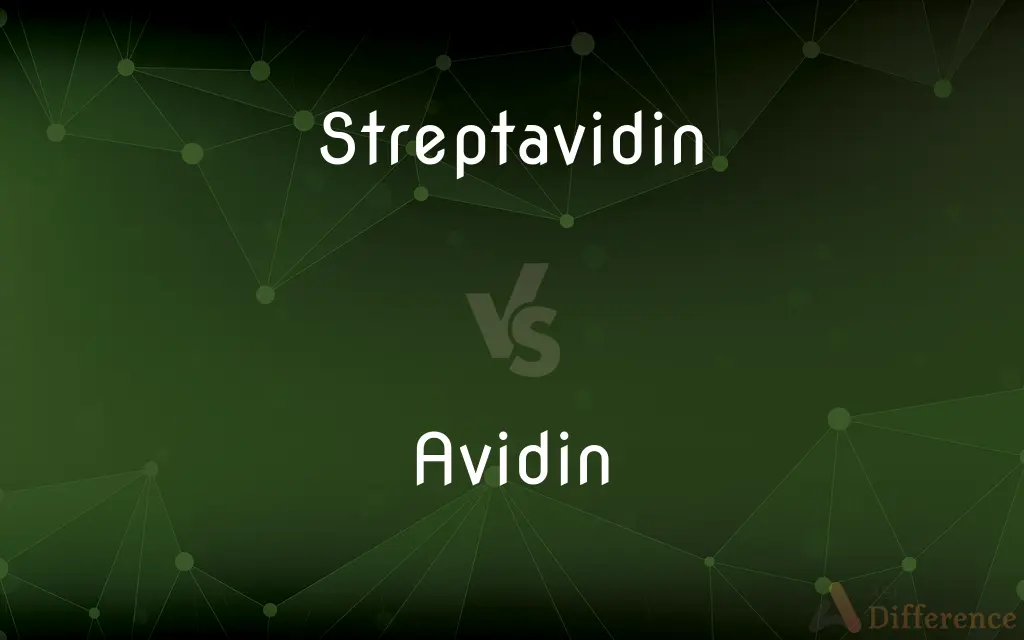Streptavidin vs. Avidin — What's the Difference?
By Fiza Rafique & Maham Liaqat — Updated on April 1, 2024
Streptavidin and avidin are both proteins that bind biotin with high affinity, but differ mainly in their source and biotin-binding properties.

Difference Between Streptavidin and Avidin
Table of Contents
ADVERTISEMENT
Key Differences
Streptavidin, derived from the bacterium Streptomyces avidinii, is known for its strong non-covalent binding to biotin, a vital nutrient. This characteristic makes it invaluable in biotechnological applications, especially in biochemical assays where precise biotin-streptavidin interactions are crucial. Unlike avidin, streptavidin lacks glycosylation, which reduces its non-specific binding to other molecules, enhancing its utility in research settings. Avidin, on the other hand, originates from egg whites and also exhibits a high affinity for biotin. Its natural role is to thwart bacterial growth by sequestering biotin, a vital nutrient for many organisms. Avidin's biotin-binding ability is exploited in various biochemical assays; however, its glycosylation can lead to higher non-specific binding compared to streptavidin. This property can sometimes limit its usefulness in certain scientific applications.
Both proteins are tetramers, meaning they consist of four subunits, which allow them to bind multiple biotin molecules simultaneously. This multivalency amplifies the sensitivity of detection methods in which they are used. However, the biotin-binding sites of avidin and streptavidin differ slightly, influencing their binding affinity and kinetics.
The difference in their source streptavidin from bacteria and avidin from egg whites—also reflects on their immunogenicity and potential applications. Streptavidin is generally preferred in applications requiring lower background noise due to its lack of glycosylation and hence, lower non-specific binding.
Despite their differences, both streptavidin and avidin find common ground in their pivotal role in biotechnological and diagnostic applications, leveraging their biotin-binding capabilities to facilitate a range of detection, purification, and labeling techniques.
Comparison Chart
Source
Streptomyces avidinii bacterium
Egg whites
ADVERTISEMENT
Glycosylation
None
Present, contributing to higher non-specific binding
Biotin-binding affinity
Very high, strong non-covalent interaction
Very high but may be influenced by glycosylation
Immunogenicity
Lower due to lack of glycosylation
Higher due to glycosylation and being a non-human protein
Applications
Preferred in research requiring low background noise
Used in various biochemical assays, with potential non-specific binding issues
Compare with Definitions
Streptavidin
A biotin-binding protein extracted from the bacterium Streptomyces avidinii, used extensively in molecular biology and biochemistry for its strong, non-covalent interaction with biotin.
Streptavidin-coated beads are often used in affinity chromatography to isolate biotinylated molecules.
Avidin
A glycoprotein found in egg whites that binds biotin with high affinity, commonly used in biochemical assays to capture biotinylated compounds.
Avidin is used in pull-down assays to isolate biotin-labeled proteins for study.
Streptavidin
Recognized for its high affinity to biotin, streptavidin is utilized in various applications including drug delivery systems and targeted therapies.
Streptavidin is used to attach biotinylated antibodies to nanoparticles for targeted drug delivery.
Avidin
A natural biotin-binding protein characterized by its tetrameric structure, allowing it to bind four biotin molecules, used in various diagnostic and research applications.
Avidin-biotin complex formation is exploited in immunohistochemistry for signal amplification.
Streptavidin
A tetrameric protein that can bind up to four biotin molecules simultaneously, allowing for versatile applications in biotechnological research and diagnostics.
Streptavidin-biotin complexes are used in ELISA tests to amplify signal detection.
Avidin
Known for its role in nature as a biotin scavenger, preventing bacterial growth by sequestering biotin, and used in labs for its strong biotin-binding properties.
Avidin coated plates are utilized in assays to detect biotinylated antibodies.
Streptavidin
A tool in biotechnology for the purification, detection, and immobilization of proteins, nucleic acids, and other molecules.
Streptavidin immobilized on a solid surface is used to capture biotin-tagged molecules for analysis.
Avidin
Used in biochemistry for the immobilization and detection of biotinylated substances, despite potential for higher background noise in assays due to its glycosylation.
Avidin is utilized in affinity columns for the purification of biotinylated peptides.
Streptavidin
A non-glycosylated protein known for its minimal nonspecific binding, making it ideal for sensitive biological assays where specificity is crucial.
Streptavidin conjugated to fluorescent dyes is used to detect biotin-labeled targets in fluorescence microscopy.
Avidin
Despite its high nonspecific binding due to glycosylation, avidin is widely used in biotechnological applications for its robust biotin affinity.
Avidin conjugates are employed in blotting techniques for detecting biotin-tagged molecules.
Streptavidin
Streptavidin is a 66.0 (tetramer) kDa protein purified from the bacterium Streptomyces avidinii. Streptavidin homo-tetramers have an extraordinarily high affinity for biotin (also known as vitamin B7 or vitamin H).
Avidin
Avidin is a tetrameric biotin-binding protein produced in the oviducts of birds, reptiles and amphibians and deposited in the whites of their eggs. Dimeric members of the avidin family are also found in some bacteria.
Streptavidin
(protein) A tetrameric protein purified from Streptomyces avidinii that binds very tightly to the vitamin biotin
Avidin
A protein found in uncooked egg white that binds to and inactivates biotin.
Avidin
(biology) A tetrameric protein produced in the oviducts of birds, reptiles and amphibians and deposited in the whites of their eggs.
Common Curiosities
Where does avidin come from?
Avidin is a protein found in egg whites.
Why is glycosylation important in the context of avidin and streptavidin?
Glycosylation affects avidin’s non-specific binding, making streptavidin, which is non-glycosylated, preferable for certain research applications to reduce background noise.
Why is streptavidin preferred in some biotechnological applications?
Its lack of glycosylation reduces non-specific binding, making it suitable for applications requiring low background noise.
How do streptavidin and avidin bind to biotin?
Both bind to biotin through non-covalent interactions, though their binding affinities and kinetics may differ.
What is streptavidin?
Streptavidin is a protein extracted from Streptomyces avidinii, known for its strong binding to biotin.
How does the structure of streptavidin and avidin affect their function?
Both are tetrameric proteins, allowing them to bind multiple biotin molecules simultaneously, which enhances the sensitivity of detection methods.
What is biotin?
Biotin is a B vitamin that is essential for various metabolic processes in living organisms.
Can streptavidin and avidin be used interchangeably in experiments?
While they can sometimes be used interchangeably, differences in glycosylation, binding affinity, and non-specific binding may influence the choice between them based on the specific requirements of the experiment.
Is streptavidin glycosylated?
No, streptavidin is not glycosylated, contributing to its lower non-specific binding.
What are the applications of streptavidin and avidin?
They are used in biotechnological and diagnostic applications, including detection, purification, and labeling of biotinylated molecules.
How do streptavidin and avidin differ in their source?
Streptavidin is bacterial in origin, while avidin is derived from egg whites.
What makes streptavidin suitable for low-background noise applications?
Its absence of glycosylation and strong non-covalent binding to biotin minimizes non-specific interactions.
Are there any variants of streptavidin or avidin used in research?
Yes, there are engineered variants with altered biotin-binding affinities and specificities for specialized applications.
What role does avidin play in nature?
Avidin naturally functions to inhibit bacterial growth by binding biotin, a vital nutrient for bacteria.
What are the limitations of using avidin in research?
Its glycosylation can lead to higher non-specific binding, potentially complicating some assays.
Share Your Discovery

Previous Comparison
Moron vs. Moran
Next Comparison
Harvard vs. OxfordAuthor Spotlight
Written by
Fiza RafiqueFiza Rafique is a skilled content writer at AskDifference.com, where she meticulously refines and enhances written pieces. Drawing from her vast editorial expertise, Fiza ensures clarity, accuracy, and precision in every article. Passionate about language, she continually seeks to elevate the quality of content for readers worldwide.
Co-written by
Maham Liaqat













































